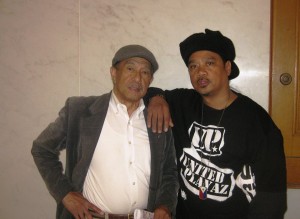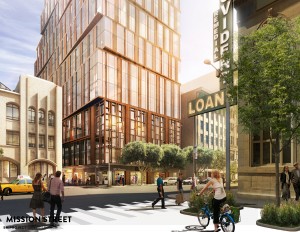Schism emerges as some Filipinos back SF’s new building project

Two Rudys: Supporters of San Francisco’s5M Project, Rudy Asercion, CEO of NaFFAA RVIII/Pacific Region, and Rudy Corpuz, executive director of United Playaz, contend that the development project would be good for the Filipino community. CONTRIBUTED PHOTO
SAN FRANCISCO — Just as there are Filipinos against the city’s 5M Project, there are also Filipinos who are all for it. The issue has tested the unity of Filipinos in the South of the Market (SOMA) neighborhood and polarized community groups who are used to working together on problems affecting the community.
In the forefront of the group supporting building project are the two Rudys — Rudy Asercion, chief executive officer of National Federation of Filipino American Association (NaFFAA) RVIII/Pacific Region, and Rudy Corpuz, executive director of United Playaz.
“I am for the 5M Forest City project because of the benefits and things for San Francisco residents including low-cost housing that they are developing, the senior and additional housing units that they are going to provide for old Filipino family residents with returning members,” Asercion stated.
He explained that the shortage of housing in San Francisco would not be solved by stopping development and construction.
Artist’s rendition of proposed 5M Project. CONTRIBUTED
The 5M Project was approved by the San Francisco Planning Commission with a vote of 4-2-1 last week. Four appointees of Mayor Ed Lee (Commission President Rodney Fong, and Commissioners Christine Johnson, Michael Antonini and Rich Hillis, all voted in favor of the project. It is going to be handled by developer Forest City and landowner Hearst Corporation and covers four acres between 5th and Mission and Howard streets.
“The main issue that divides supporters and oppositors is the number of low cost housing units developers are willing to provide. There are some demands for 33 percent of the total project for low-cost housing, and the developers are willing to at least meet the minimum city requirement of 12 percent,” Asercion asserted.
“Let us face it, the developers are there to develop and make money because they are investors and they have to recoup their investments. They have to get a return on their investments. And if they ultimately make it unprofitable for investors and developers to construct housing, how are we going to resolve the shortage of housing in San Francisco,” assertion argued.
The mixed-use housing and office project, according to the 5M Project fact sheet, includes 33 percent affordable housing, new open space for the neighborhood, support for cultural and youth programs and restoration of historic buildings.
Opponents, however, contend that only 8.5 percent (58 of 600 units) of the total units on site are for affordable housing.
Asercion acknowledged that there are low-income people that cannot afford the high cost of living in San Francisco due to their low wages. The solution, he said, is that for them to go school and get educated to be able to get higher paying jobs.
“We are talking about Filipinos who can change the landscape of San Francisco by making a difference. We need to change, to grow and develop. We just cannot keep on saying we need poor Filipinos to stay in San Francisco. How are we going to progress if that is the mentality?”
He further opined that Filipinos need to forget that they are “so helpless,” for it discourages the youth whose self-esteem should be developed into a mindset that Filipinos are ready to change the politics of the city.
For his part, United Playaz’s Corpuz admitted having mixed feelings when asked about his reaction on the approval of the planning commission of the 5M Project.
“I am happy, but then I am not happy. I am happy because change is good in the community,” Corpuz admitted. “I’m sad at the same time because I know a lot of people in the community, particularly a lot of Filipinos, are not happy about the situation.”
On the other hand, Filipino senior Stephanie Menchavez, who also spoke in the Planning Committee hearing that green-lighted the project, expressed elation that it was approved.
“I have the feeling that it is going to be approved because these commissioners are not bobo; they studied the project well and knew it is good for the city for it will give 3,500 jobs. It was approved because the commissioners thought it is good for the city. Those who are against it are jealous and are employing the crab mentality for pulling down those who are wanting to go up,” Menchavez declared.
Menchavez added that she no longer wants seniors like her to go back to a building that is old and vulnerable in earthquakes or any disaster.
To try to heal the rift among Filipino community groups, Asercion suggested that the opposing camps band together and lobby for a Filipino Community Center that has been in the back burner for 20 years.
“The opposing groups should sit down, get together so we can talk about this and come up with a concession from the 5M Project to have a Filipino Community Center,” Asercion proposed. I suggest that we assign the Victoria Manalo Draves Park as the anchor institution for a Filipino Heritage District where we could have a Filipino-themed park.”

Rally in front of San Francisco City Hall against evictions and for low-cost housing. PHOTO BY JUN NUCUM
Corpus too believes that sitting down and figuring out together what’s best for the people in the community would help a lot in re-establishing the bond that was weakened.
“I already initiated the dialogue. I went to them and talked with the people from the other group. I said we need to sit down and figure out for what is best for the neighborhood, even with the differences. Their response was, ‘We’ll get back to you.’”
Corpus said emotions were still running high and that there still were people who felt hurt. Given time, Corpuz, believed, they would be able to get over the hurt and be open to talk things out.
The two Rudys stated that 5M Project developer, Forest City, was willing to support and help make the Filipino Historical District a reality.
“That is why we have to get together and have a list of requests ready so that the developer would know what we want and help out as they committed in the hearing,” Corpuz reiterated.
“Now is time for us to get it incorporated formally into the plan of the 5M. We all have to move forward as a community and work together for the betterment of the people in the loop—black, white, Latino, Filipino, Samoan—all of us and everybody that coexist in the community, rich and poor.”
Like us on Facebook


